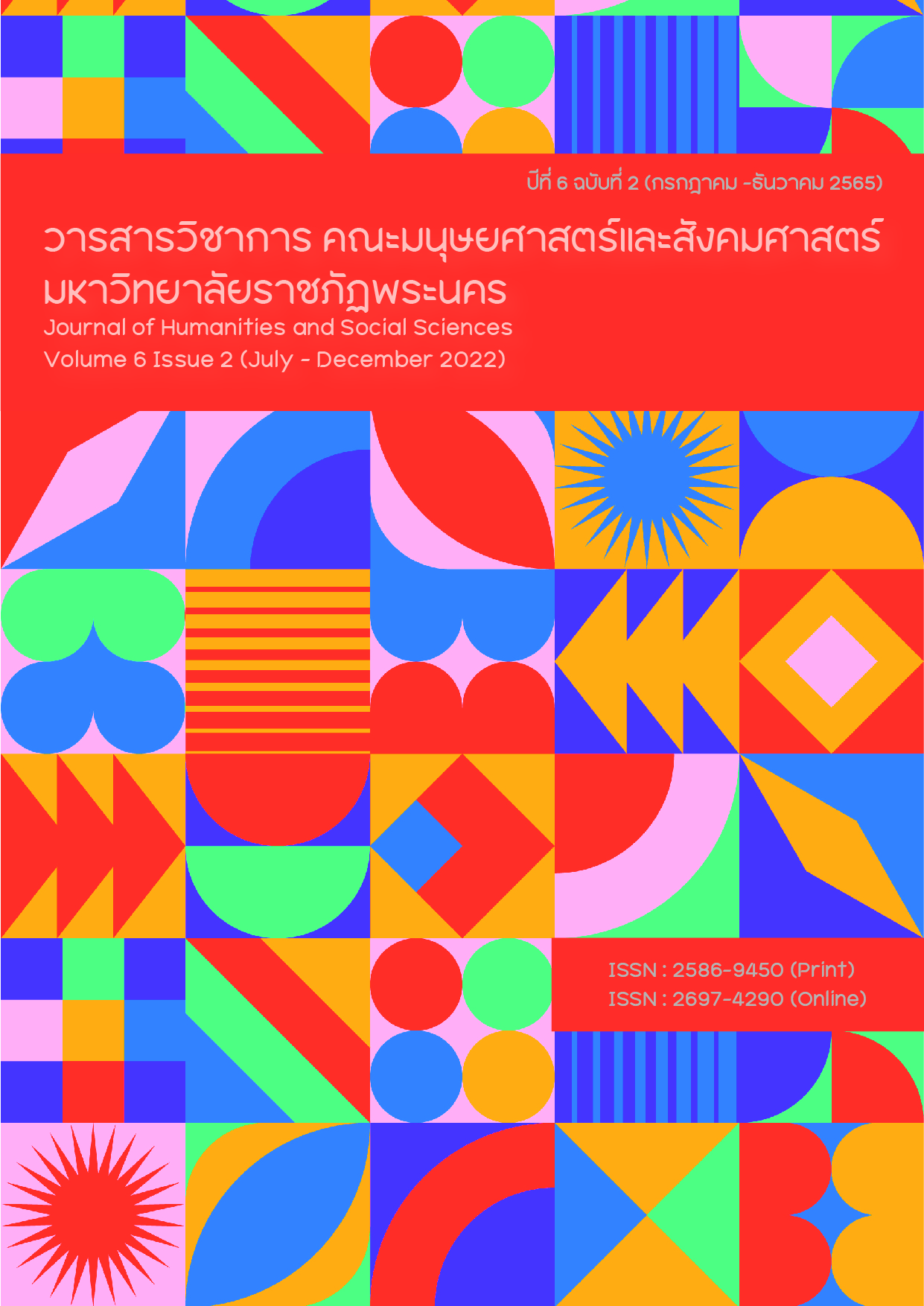การศึกษารูปแบบการแปลชื่อภาพยนตร์จีนแนวสิ่งลี้ลับที่ฉายในประเทศไทย ตั้งแต่ปี ค.ศ.1980 – 2013
Main Article Content
บทคัดย่อ
บทความนี้มีวัตถุประสงค์เพื่อศึกษารูปแบบการแปลชื่อภาพยนตร์จีนแนวสิ่งลี้ลับที่ฉายในประเทศไทยตั้งแต่ปี ค.ศ.1980 – 2013 ใช้วิธีศึกษาเปรียบเทียบและวิเคราะห์ชื่อภาพยนตร์ที่สามารถสืบค้นข้อมูลได้ จำนวน 63 เรื่อง โดยยึดชื่อภาษาจีนต้นฉบับและชื่อภาษาไทยเป็นหลัก และพิจารณาชื่อภาษาอังกฤษประกอบ
ผลการศึกษาพบว่า ชื่อภาพยนตร์จีนแนวสิ่งลี้ลับที่ฉายในประเทศไทยตั้งแต่ปี ค.ศ.1980 – 2013 ไม่ปรากฏวิธีการแปลชื่อเรื่องแบบตรงตัว ใช้วิธีการแปลชื่อเรื่องโดยเลือกใช้คำบางส่วนจากภาษาจีนต้นฉบับและใช้คำใหม่อีกส่วนหนึ่ง จำนวน 9 เรื่อง คิดเป็น 14.28% แปลชื่อเรื่องโดยเลือกใช้คำบางส่วนจากชื่อแปลภาษาอังกฤษและใช้คำใหม่อีกส่วนหนึ่ง จำนวน 3 เรื่อง คิดเป็น 4.76% ส่วนภาพยนตร์ที่เหลือ จำนวน 51 เรื่อง ใช้วิธีการตั้งชื่อใหม่ คิดเป็น 80.95% จากจำนวนภาพยนตร์ทั้งหมด ประเด็นที่น่าสนใจคือ ภาพยนตร์หลายเรื่องเป็นภาคต่อกัน แต่ถูกแปลให้เหมือนไม่ใช่เกี่ยวเนื่องกัน เช่น ภาพยนตร์ชุด 开心鬼 หรือ Happy ghost และภาพยนตร์อีกหลายเรื่องไม่ใช่ภาคต่อกัน แต่กลับถูกแปลให้เชื่อมโยงเหมือนเป็นภาคต่อกัน เห็นได้อย่างชัดเจนจากกลุ่มภาพยนตร์ที่ปรากฏคำว่า ผีกัด และ กัด มีมากถึง 18 เรื่อง คิดเป็น 28.57% ของจำนวนภาพยนตร์ทั้งหมด และกลุ่มภาพยนตร์ที่ปรากฏคำว่า โปเย และ โปเยโปโลเย
สรุปได้ว่า การแปลชื่อภาพยนตร์ควรใช้วิธีการแปลแบบเน้นความเข้าใจของผู้ชมในภาษาเป้าหมาย (Target Language - TL emphasis) ดังนั้น ผู้แปลจึงนิยมแปลโดยใช้วิธีการตั้งชื่อเรื่องใหม่และเลือกใช้คำที่อยู่ในกระแสนิยมหรือเป็นส่วนหนึ่งของชื่อภาพยนตร์ที่ประสบความสำเร็จโด่งดัง ซึ่งสอดคล้องกับทฤษฎีการกระทำการแปล และ การแปลโดยคำนึงถึง “หน้าที่” เป็นสำคัญ ของ Nord, C. (1989) เพื่อเหตุผลทางการตลาด
Article Details
เอกสารอ้างอิง
Banyapon Poolsawas. (2016). Rigor Mortis (2013) Full of ghosts, awakening a legend for
years, ghosts bite, don't bite back. Retrieved 15 March 2021, From
http://www.lovedesigner.net/rigor-mortis-2013/
Cheng Yingfen. (2557). A Comparative Study in Techniques of Translating Movie Titles
from Chinese into Thai and from Thai into Chinese. Master of Arts (Communication
Thai as a Second Language) Thesis. Bangkok. Huachiew Chalermprakiet University.
Ekachai Saengjantanu. (2563). Translating Thai Drama Titles and Thai TV Series Titles into
Chinese: Strategies and Analysis. Journal of Human Sciences, 21(1), 116-136.
Jindaporn Pinpongsub. (2561). The Method of Translating the Title of Thai Movies to
Chinese. Veridian E-Journal, 11(3),1471-1491.
Kamontip Rakkiattiyod. (2562). A Study of Chinese Vocabulary Having the Same
Morphemes but Opposite in Order. Journal of Humanities and Social Sciences, 3(1), 96-113.
Kanokporn Numtong. (2552). Study of the translation of Chinese novel "Romance of the
Western Han" in King Rama I period: Final research report. Bangkok. Kasetsart
University.
Kanokporn Numtong. (2563). The Study of Translation Problems of the Attributives and
Complements from Chinese to Thai for Developing Chinese to Thai Tranlation Skills.
Journal of Language and Linguistics, 38(2), 89-105.
Kao Krabi Deaw Kai. (2019). Po-Ye Po-Lo-Ye: Strange stories from the library. Retrieved 10
March 2021, From
Kullayanee Kittopakarnkit. (2563). Translating Thai Horror Film Titles into Chinese:
Strategies and Analysis. Humanities and Social Sciences Journal of Pibulsongkram
Rajabhat University, 21(2), 354-373.
Patnapa Sukprasert, and Sarawoot Khawperk. (2563). Analysis of Social Change and
Narrative Techniques of Chinese Literature in Thai Version “To Live” by Yu Huo.
HUSO Journal of Humanities and Social Sciences, 4(1), 68-89.
Peter Newmark. (1988). A Textbook of Translation. Hertfordshire: Prentice Hall.
Prissana Fongsarun. (2550). The Usage of Thai Title for Chinese Films. Master of Arts
(Thai) Thesis. Bangkok. Kasetsart University.
Royal Society of Thailand. (2554). Dictionary. Bangkok: Nanmeebooks.
studiolens. (2020). History of Thai cinema. Retrieved 11 March 2021, From
https://www.studiolens.com/ประวัติภาพยนตร์ไทย/
Wanna Saengaramruang. (2563). Theories of Translation. Bangkok: Chulalongkorn University Press.
Wu Zhiyuan, and Lan Xialing. (2021). Analysis of Chinese Translation of Titles of Popular
Thai TV Dramas. Jin Gu Wen Chuang, 2021(1), 109-111.
https://www.facebook.com/159523637959342/posts/443862356192134/


